Chapter 1. New Virtual Lab Demo
Home
Lab 1: Scientific Method
Welcome to the Biology Exploration Laboratory!
In this lab, we will explore various aspects of the biological sciences, including cell theory, genetics, energy processing, and evolution, among other topics. We will explore the world around us and inside us, and you will learn more about yourself than you ever thought possible.
The purpose of this first lab is to get you more acquainted with our virtual laboratory environment and more familiar with the scientific method. Today we will focus on experimental design – crafting comprehensive and through investigations designed to answer a specific question or test a hypothesis. We will also work on collecting both qualitative data and quantitative data, then communicating the data to other scientists. Lastly, at the end of this lab you will write your first lab report.
Are you ready to begin?
Background Info
All scientific experiments begin with learning as much as possible about the subject first. To help with that, you’ve been provided with some background material on the scientific method, types of scientific data, and South American ecosystems. Read this material thoroughly. Then, proceed to the comprehension questions that follow.
Data collection and the scientific method.
Biologists have two major approaches to science: observational and experimental. The observational approach is just what it sounds like: observing something about the natural world. The experimental approach is used to test a prediction that is based on an earlier observation.
The data gathered by a researcher can be either qualitative or quantitative. Qualitative data is descriptive. This could include observations such as:
- The color of a bird’s feathers
- The organization of the nephrons within the kidney
- The courtship behaviors of frogs
Quantitative data requires some kind of objective measurement. Time, temperature, weight, and volume are all things that are quantitative. Quantitative data could be:
- How many red feathers the bird has
- The rate at which the nephrons filter the bloodstream
- How often a female frog mates with a male in a 24 hour period
Very often, qualitative data leads to quantitative data. An investigation of a biological phenomenon generally starts with describing what exists. The next step is to try to understand the cause - an explanation of why something works the way it does. For example, a biologist might notice that a particular species of plant grows better in the summer than in the spring. But there could be many reasons why that would occur. It could be because the days are longer, or because the temperature is higher, or because there is greater rainfall in the summer. Any one of these factors, or possibly a combination of them, could improve plant growth. How could a biologist determine which is the true cause?
The process that a biologist will use is called the scientific method.
In order to learn the answer, the biologist needs to develop a hypothesis. A hypothesis is a possible explanation for a previously observed phenomenon. In order for a hypothesis to be useful, it must be testable. This means that the hypothesis makes a prediction. Often this prediction can be phrased as an “If…then” type of statement. In this example, the biologist might hypothesize that longer days make the plant grow faster because the plant gets more sunlight. If longer days cause faster growth, then shorter days should cause less growth. This is a testable statement with a yes/no answer. The biologist can set up an experiment that will allow him/her to see if this hypothesis is supported by quantitative data.
As he/she sets up this experiment, however, the biologist must take into account the other factors that could affect the outcome of the experiment. The best methodology is the controlled experiment. In this format, the biologist essentially performs two experiments in parallel, with the only difference between them being the variable that is being tested. This way, nothing but the variable being tested can affect the results. So in this example of a plant growth experiment, there will be four groups of plants. Each group is kept at the same temperature and receives the same amount of water. The only difference between them is the day length. Therefore, if the group with longest days grows the most, it can only be for one reason: day length is causing increased growth.
Quantitative data is presented in some kind of graphic format. This makes the results easy to interpret. A graph will display an independent variable and a dependent variable. The dependent variable is the one that is affected by the other variable, and is typically the focus of the experiment. The independent variable is not affected by the other variable, and is being controlled by the biologist. For example, in this plant growth experiment, the independent variable is day length while the dependent variable is growth. Growth depends on day length, but day length does not depend on growth.
The dependent variable will always be on the y-axis (vertical axis) of the graph, and the independent variable will be on the x-axis (horizontal axis). The axes must be clearly labeled, including the units of measurement. It is necessary that someone be able to understand the experimental results simply by viewing the graph. An example of such a graph is given below.

From reading this graph, it is clear that day length did have an effect on plant growth. As the days got longer, the plant grew more. This means that the hypothesis is supported. The word “proven” is almost never used by biologists. There might be other conditions under which this hypothesis would not be supported (for example, many plants can grow in the winter, when days are short). But for this experiment, this hypothesis can explain the observed phenomenon. Future experiments can be based on these results. For example, the next hypothesis might be that, since increasing day length increases growth, 24 hours of sunlight will cause even more growth. This is a testable hypothesis that is based on the results of this experiment.
What if the graph had looked like this?

Here, it is obvious that day length had no effect on growth. In this case, the hypothesis would be rejected. Whatever is causing increased growth in the summer, it is definitely not day length. The biologist would then design a new experiment testing a completely different variable. Even though hypothesis was not supported by the data, the biologist still learned something important from it, so this experiment was not a failure.
This process of generating a hypothesis and testing it is called the scientific method. It follows the pattern in the example described above. The steps involved are summarized here:
- An observation leads to a question. What is the cause of this phenomenon?
- A testable hypothesis is generated. The hypothesis proposes an answer to the question.
- A controlled experiment is designed to test the hypothesis.
- The results are graphed to demonstrate whether the hypothesis is supported or rejected by the data.
- If the hypothesis is supported, it can be accepted as an explanation for this phenomenon. More experiments may arise for further in-depth testing.
- If the hypothesis is rejected, the biologist must look for another explanation of this phenomenon and develop a new hypothesis to test it.
Using the scientific method for animal conservation.
In this lab, you will be acting as an animal researcher for a major zoo. A previously undescribed animal species from South America has just been brought to you. It is very rare in the wild; the specimens you have are the only ones in captivity and may be necessary to help reestablish the population in the wild. It is therefore very important that you be able to keep these animals alive, healthy, and reproducing. To do this, you will need to determine what kind of environment and diet they need. Unfortunately, the researchers who collected these specimens did not keep notes, and you have no idea where in South America they were found. Those researchers have gone back to find more animals, so that eventually these animals can be returned to the wild. But until then, it is all up to you.
What observations can you make about these specimens? First, you can say that they are definitely insects. They have a hard exoskeleton, six legs, large compound eyes, wings, and long antennae. They have a bright green carapace with black spots near the back legs. Some are much larger than others.
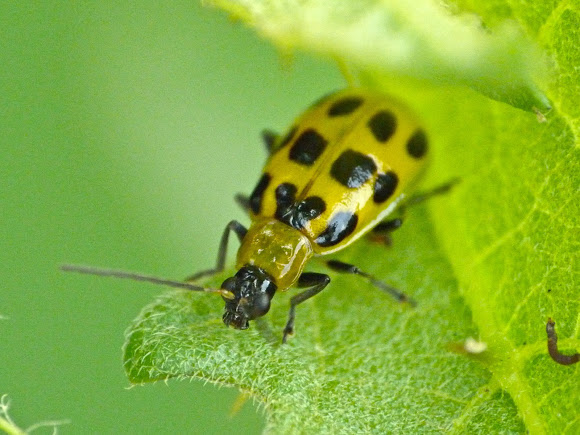
What are some typical features of insects that might be useful to take into consideration?
- Most insects are herbivores and can do major damage to crops.
- There are definitely examples of insects that eat meat, generally other insects.
- Some insects show sexual dimorphism, where males and females are very different in color and/or size.
- Some insects show ametabolous metamorphosis, where the young are essentially smaller versions of the adults.
- Insects cannot regulate their own body temperature, and therefore depend on the external environment for energy.
- Very few insects fly at night because they cannot get warm enough.
- Animals that live in deserts are adapted to need little water.
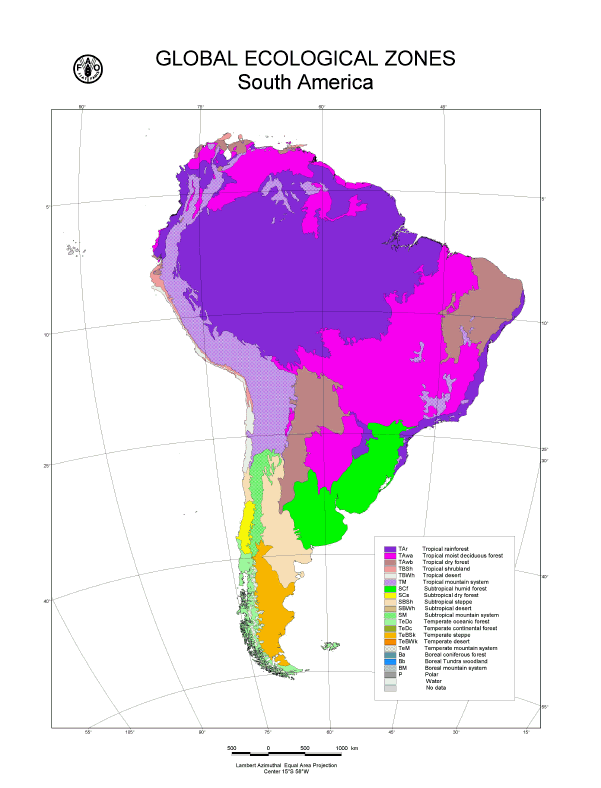
South America is a very diverse continent, with a wide range of ecosystems. What features of this continent should you keep in mind as you study these insects?
- Ecosystems vary from mountain to rainforest to deciduous forest to grassland to desert.
- Over most of the continent, average temperature is higher than 68 °F year round. However, the mountains and grasslands can get significantly colder.
- Rainfall and humidity range from very high in the rainforests to very low in the deserts.
So, there are many potential conditions these insects could have lived in. What conditions are the best? That is what you are going to determine, using the scientific method.
Pre-lab Prep
Now that you have read the background information, answer the following questions. You must get a score of 90% or better on these questions to proceed to the first experiment.
Question 1.1
Choose whether each of the following represents qualitative or quantitative data.
• Weight of an animal in kilograms iY4P9pCBnKBeuU01EeYthLMgalIBeZ08EORWBQ==
• How DNA strands are wound around proteins LregB5uxCK4vntIT8wZvsBk13G1u5e0HmLybOw==
• Height of a tree in meters iY4P9pCBnKBeuU01EeYthLMgalIBeZ08EORWBQ==
• Colors of a butterfly’s wing LregB5uxCK4vntIT8wZvsBk13G1u5e0HmLybOw==
Question 1.2
bWaKjTAmA1Lukr2qPqSK1Q6SaaHa3beIrbHqNM09Skcy/plXairrTtl0bDDMWcLV5WuHVZ64vgzzZQoeJr/dnvSV3CCopSZhPC34Ha9w6wbPMQhf3huWiReSLgjK2HN8es4QBr53l/pWBk219i9tf3ptBoUj7kqgvx8NTwQxVio3AABxkwnuKS79GRzSkp8iBIYaSy/m3shLai6uNGfMAFIrTwI+7eUkO6dyl7LGrSjUYqvVgmELydPP19Dca0NGKfHituBg7Y8Vfs24NlulKuqy5PNhDRyKldNbmIRB4jZLDfhCJBvlqYswM2De834/ppPw7NKm3xqAWcDcfBY1j/QOV232B/HlKHIBj9BsFGfAAvBc1L0QVp9epTcJAJ57dnM/7I2kDS8KUWmChpi4ckKiAwLmWaHeZbpq77O12iEVo2vaHuF8qxc8HeW9Gt5d0wwdZ5YammzBAoU5pjeQphKwlGSFEpzvxkKHcoev3SrKCPR5Ea4E70iIciaelFH3Question 1.3
wtz3CPc4RVNonTabeIP3Neis0InK0WPG0E5019VYUdhgP5Su7SejaFys+1aJtXaJct/c5JIBXaR94q4uqZDvBzjZnCHke3YmSP/1BOcTU4cXCuc9tHyxOMGQdY8ZrvSPT/KCgu63YfDEizt58preJmNZqvQMKUgA8K8vJnznOOYH1QOhol0iJjpGvn6jwpHX61Zm/CirUR1E88kEblcsaMo/gdRvi05eJenn8OT08pIH6XuDAnGofySUKfYtd2gOgmJxSjHtcVpm5lEUdZK9ADaS0MSQLu4E859wab2y0YNhWcSUIU1R8svLpYCtr3q2Q0mQA1BigQjdEWTLrc6rbqQKir1qNGmS62KZx30YYieFoz7xc2DHj99yD4GUuUzxkFsMt+EuD3i114Ybi+5Y3lSapqlHhi95IAT0gadgriuqSBWqxWFtnYw1hh2ip7ssqHV/8TPq0E8=Question 1.4
For each of the pairs below, determine which is the dependent variable and which is the independent variable:
• A medication that lowers blood pressure
Independent variable: beHW5VV+cHZ4yrcCeXYObweAKv7HUEYXvSvp4YLwyNM=
Dependent variable: 3XfGcDqg8uUIOVkmtIlvi9v+AOsHhJmsSwlp3MAydzU=
• The way plant growth is affected by different fertilizers
Independent variable: 5JFsq3z6JcT8XHVo6M5CMD4B4jQ+PPyisMuv8Q==
Dependent variable: zG+vRp/hWJ5PLWjl414yrFkmJFSfrxBRmmHHiA==
• Air temperature and the rate of water evaporation from a leaf
Independent variable: ZPdIgUgIcKGJftdtB2m5ZzznSlfLaHQnqcVv/FqEBsGelI2t
Dependent variable: J5pF981CVFHcCnp+gZtqVajpmYBmWbVS2PnqS56mM6yoMYzh
• Effect of an antibiotic on bacterial growth
Independent variable: iYE+I8XoNoVP1jsPBxNJ5Xn8vO8/+OrQMI6kTEGoj/0=
Dependent variable: mwvtmf8Aelxe5o+9tbN9qjUjuJzxNeiTZvLU+ChyQLA=
An experiment was done to study the effect of dietary fat intake on blood cholesterol levels. The hypothesis was that increasing fat intake would increase cholesterol levels. The results are shown below.

Question 1.5
Which is the independent variable? a52yWKF2JZII1T5TB3wxpNtVnVHRIhHgIulY9GFOn2K3S8qrKZes7G5qHzSFMZhd

Question 1.6
Referring to the graph above, place the correct label on the correct axis.
Blood cholesterol levels in milligrams/deciliter iFvW9XnNj4ItpJvjtFjOPFopQXQ=
Dietary fat intake in grams/day RvozsYSzFT7DoqYWLuuCZSfWdH8=
Question 1.7
7PETwAIDtX4kEJHOMGdaUlhxY3HxHscUvPN082gd5d3GCKnNfjOAWCVA50gE/wN7xqi9vc+MAeMHA+cEl99iXqcRDdwWGfC6KcQLy+8bz4yTFGqcV0gHYl/FQgTxC5gP6C+5rV63V7YzXYDNdE9aUva3tt+edsS7B+OQk7zOTCU9Dzz+J4wVrZYRBq/Dm+zi1QVTQy6oqm3WKmaN6WouEcCaXUMDg3rvKHts3w==Question 1.8
Do the data support or reject the hypothesis? giaX/+1cCebjGtSOoq4ZWIOPido=
Question 1.9
Which of the following describe the animal you will be studying today? Select multiple correct answers.
| wCfH0QtRgXJ8o+c+ | Bird |
| bI0LPa9lfHQ+dYqk | Insect |
| wCfH0QtRgXJ8o+c+ | Eight legs |
| bI0LPa9lfHQ+dYqk | Wings |
| wCfH0QtRgXJ8o+c+ | Blue |
| wCfH0QtRgXJ8o+c+ | Able to control its body temperature internally |
Question 1.10
Which of the following ecosystems are NOT found in South America? Select multiple correct answers.
| wCfH0QtRgXJ8o+c+ | Rain forest |
| bI0LPa9lfHQ+dYqk | Tundra |
| wCfH0QtRgXJ8o+c+ | Desert |
| wCfH0QtRgXJ8o+c+ | Deciduous forest |
| bI0LPa9lfHQ+dYqk | Mangrove swamp |
Experiment

1.3.1 Observational Science and Qualitative Data
Your laboratory has been sent a collection of individuals from a newly discovered species found in South America. You’ve been tasked with discovering how best to keep these animals alive – the best habitat for them to live in, the best diet to feed them, etc. The data you collect will be used to construct the ideal zoo habitat for this species, so it is important these experiments be done carefully and accurately.
Question 1.11
sLcwk20JzmlYkzPzbtYjHBZC1LdXE+1RGvBYQJCyazJrwH0VmVjjPKsk+/GKltSIzPcDKJiyqocOEYmNpUSsAWD+EDNQsixw7iPmRfAs5Sz2XvZDWe will first determine how this organism reacts to a variety of different stimuli. The table below lists these different objects and conditions to which we can expose the organism. For each, write your predictions for how you think the organisms will respond to these possible stimuli. Your predictions do not have to be correct (you only will be graded for entering a response) – they simply represent your best guess as to how the organisms will respond to the stimulus.
| Expected Response | |
|---|---|
| Bright Light | ES: lhF+ssIo1A8= |
| Darkness | ES: lhF+ssIo1A8= |
| Meat | ES: lhF+ssIo1A8= |
| Dry Cereal | ES: lhF+ssIo1A8= |
| Apple | ES: lhF+ssIo1A8= |
| Lemon Juice | ES: lhF+ssIo1A8= |
| Water | ES: lhF+ssIo1A8= |
| Soda water | ES: lhF+ssIo1A8= |
Now that you have entered the "Expected Response" to each stimulant, proceed to the experiment module by clicking the "Launch Experiment Module" button to conduct your first experiment.
After launching the experiment module, you will click and drag each stimulant into one of the cages on the table. Note: you can only test one substance per cage.
After the first test, make notes about the organisms' responses to the stimulants. Then, minimize the experiment module, and record the organisms' "Actual Response" to the stimulants you tested in the table below.

Repeat these steps until you have tested the organisms' responses to every substance. Once you have filled out the table, you'll be able to proceed to the next step in this activity.
Question 1.12
Enter the organisms' responses to each stimulant in the "Actual Response" column below.
| Expected Response | Actual Response | |
|---|---|---|
| Bright Light | Previous answer saved | lhF+ssIo1A8= |
| Darkness | Previous answer saved | lhF+ssIo1A8= |
| Meat | Previous answer saved | lhF+ssIo1A8= |
| Dry Cereal | Previous answer saved | lhF+ssIo1A8= |
| Apple | Previous answer saved | lhF+ssIo1A8= |
| Lemon Juice | Previous answer saved | lhF+ssIo1A8= |
| Water | Previous answer saved | lhF+ssIo1A8= |
| Soda water | Previous answer saved | lhF+ssIo1A8= |
Question 1.13
yenOyZaq0bhv1OuttmMRrvGOAMK9gJKd9h3CTcaSelZI9+VmO5t2WRHqgyrAUMVxvcyewjQYvZEegYbsD2v5o8HaRSmjB/AOW3ULsmWYr8J05bvn9H8RBC6Whcl0N1T+Iid1quQIg1W0B4tsbYEXi/twFiBMmBf8Question 1.14
3tCt+afG9vATqHgkRRZpL3XuUWPvZnR5q8JzeRdXZpbuSY/fR/sZGAL9M9X8aNqcvD6TJ8pZI4TYaiC7aMDFfCjqL5MQ7/xc7MQWmpGUZf0=Using what you know about organisms so far, you are going to create a hypothesis, then design an experiment to test it. Remember, a good hypothesis is an idea, supported by observations, that leads to predictions that can be tested by experimentation. For example:
"I think that organisms like noise." (hypothesis) "So if we make different noises around the organisms, they will respond with increased activity." (prediction)
To test this hypothesis, we would expose the organisms to different types of noises, then observe and record the organisms' response.
In the next section, you are going to design and run your own experiment to test an hypothesis. To help you with this, we will provide the various stimuli listed below:
| Hot water | Banana |
| Metal Paperclip | Shade |
| Cold water | Milk |
| Warm Oatmeal | Ammonia |
| Slice of Pear | Raw Pasta |
| Heat Lamp | Iodine |
| Cold Air | Ice |
| Cooked Macaroni | Rat Poison |
| Hydrochloric Acid | Chopped nuts |
| Apple Juice | Paper |
You have to create a hypothesis that leads to a prediction that can be tested with THREE of these substances. YOU DO NOT HAVE TO USE ALL OF THESE SUBSTANCES IN YOUR EXPERIMENT. NOTE: Many hypotheses are possible. You only have devise and test one of them.
Question 1.15
4li1IEDDdd/g28jGLAWs2SREt69Ze951by2Edg==Question 1.16
5WapVE0H9owLW31yf2l2RLvND1HIYnEZ8jjBsihv6eyA3eW0tFW8A2k7ngnMNWiR+0Xh2CP4zymbmshD1vWEOzF72du6WjNcX1oaS11M+1+AUWTsQuestion 1.17
What three stimulants will you use to test your hypothesis?
DR1S3/IP0vv3rExt3UCjtgYm6quCN303R0Qd1K3OCkbVFSzI7zk3Vo2ppqM+xI93uZL07Yd3h4zj3c/qqWfSp75iTQpgM22ixA25/TlkAV1DSDcb3O4WNdI1Q98ck6n0P6te+H1V+cXbjtAwivmvxgVrs17DEzxAtZ70Ikk2Z5IGR7kNeP5KtFw6OVTdSRgujhOknOt/whyIgz87v5JooxqdQ160OixeF4M6ih/3rgrV3GLaLIwf0jzjfpVRAU3Cx5Wmoc6pXZYHO9atX5UxeZqoGDwoGCGwqeJOtA==
S2x2cjuVHP4A2vqQnFHnO1k9at5KRNdmHyyRsLuHDpHJvHvZdgbSClgbb6/LX2yjH2O3CAAs7O5fv2M1nyIwUKQgP8csyZzHG4z6BxSvIH5mMboo9P4opROxg3dwOC6OZij3/tuGkIgq2uxysINPP7Sw1fgDa8beGUpxXlNbg5Pt6MZU/zYzEjGvLuHud5OiD1ekZ4WAD1EO1sW2v9J9BKWpcSqBAgJfjwVj3OsLXs8eMDJXWd0MC2qbVEin83N+gJ+YihsMzKlq2L3RdTQGVtpoYP6V5cCJj7NE6g==
Mz2XOAfYWSS4zjX9UIYsX9Q/7tsfbqHhpbTG2W23Ay/pMsI+6XvIeqCF7MhL0uBjwCEtEPzI4SXbJfVwl58ogTvTbOiLoPLO/S6W8rchYyq+u/2w4ssY9ygSbnKUTTO7Hi3eSD8fvjD9/27B/tdil4jpNBvOCw0n8WORrjbGITSoY1bbr84NzKD+wbWYrWFOLXXuRWIwWXDvBvoVjDlcQ28I0Ds5kGJCZ4iK8W4hQCX8u0v4jajN5vnDFF8iBfLv1IJuyT19iac+qleibkVuVyCjux4DyRg2
Good scientific experiments always include a control – something that we can compare our results to and see exactly what effect our experiment had.
For example, if we were testing to see if the organism responds favorably to noise, a good control would be organisms with no noise at all. Any differences between them and the organisms that were subjected to noise could be recorded.
Question 1.18
What will you use as the control in your experiment?
m4WvcaZa0PPOrMDPQKd/Fp1HtndInYaLXaagB/mes6mew1c76T3CJ+Ln4h6aAJQEaxP0530/T6t/1w6kRf39XuOgyLukMkgaLH4Mq4Ifc+bpdWIbWvRtydYEko8P4L1Q8Fn5wCLvCEG9hIt3ZQStWGIsaIC1S+8vt8A7/HCs5rXcEe/Unj7DMEXq55vkShp2IBl9oOMmrh5lfisA2fkd+MKnAupcRB3yYzAHw3aWskuA/rABPj56893+jUFc9brbbq2Z1F0TUcdKYhUmWz4G70bTLCw=
Question 1.19
bSUSuVSTnv1SYBCnya6W6gtCOUDmL2rLklXH6gu5kK3XWdJcWsaqopkUnq/eJBTUThis is the end of Section 1 of this assignment. In the next section, we will actually run your experiment and collect data from it.
1.3.2 Running the Experiment
The laboratory has been changed to allow you to carry out the experiment that you have devised. Your three test substances and control substance are now available for you to use. Before you begin, though, record your predicted responses (assuming your hypothesis is true) in the table below.
Question 1.20
| Predicted Response | |
|---|---|
| Ice | lhF+ssIo1A8= |
| Hot water | lhF+ssIo1A8= |
| Milk | lhF+ssIo1A8= |
| Cold water | lhF+ssIo1A8= |

Once you have recorded your predictions for each substance, go to the laboratory and test the substances with our organism. Record the observed responses in the table below, then answer the questions that follow.
Question 1.21
| Predicted Response | Observed Response | |
|---|---|---|
| Ice | Recorded response from above | lhF+ssIo1A8= |
| Hot water | Recorded response from above | lhF+ssIo1A8= |
| Milk | Recorded response from above | lhF+ssIo1A8= |
| Cold Water | Recorded response from above | lhF+ssIo1A8= |
Remember, your hypothesis was:
Insert student hypothesis (copied from section 2)
And your prediction was:
insert student prediction (copied from section 2)
Question 1.22
Based on your experiment, do you support or reject your hypothesis? giaX/+1cCebjGtSOoq4ZWIOPido=
Question 1.23
s6IyAyfLdwJycLOvPDsU+Z3ScdJxgKJd/2F4K9LXHaQrievnxZvhc8gGt/fgtAmY4M3xPT7woPfWLopdPBBJQlOMUvd8RfxiOfJzGTr7zYs=IMPORTANT NOTE: In science, a rejected hypothesis is just as important as a supported one – BOTH are informative. It is more important that you be honest than that your hypothesis be correct!
Question 1.24
2NNsQCg8gNzSNojtE8lfhKf3j2+Xjig40iPuY+Mrg2eTENvy9jNxIGYz7C7uF1gTUN1JPhikDrobGBWgqY6LgR6yyaiTXb9x15undUg/Ec25KS9Yw1iD/PxTW1ynNOKgWKnSDkjZu4YgarO3r+JPgyBC1nrcfxlFbVZJgi5V5dA630phnZhNW13hjtO/Uiyn1yjzWuovrtxDbKV5XdfZB+IHZFXaOoRvE9JvO/Jd7NOrWp1Fx1uhipw9ypUZV9jCXN+ja0FLr8QrFhuMizcOs5Fg0/8/rA1TauhZ6X+eu9BjhW9EZXA/GXMev0pQs3SMp9OE+fkJ9iWuzozA2yhqay07h6vR2IBjVwFFTdGz24NIkBGSbT0Ng9deoSIpbnYo/zE+xFAKj3xDbcidr/giZ18TGMYLV56W+92Qb9Tu2m6jkaOrnx/PoJuw3Ny8e+kT1.3.3 Testing Multiple Variables
In this section, we will try to determine the best environment for keeping our new organism alive in the laboratory. We will want to mimic its natural environment as closely as possible. Your task is to figure out the optimal light and temperature levels for this organism. We have other people in the lab running experiments to determine the best humidity, soil type, vegetation, etc. (Remember, science is collaborative! Great scientists always work together!)
In this round of experiments, we are going to look at three different light levels – bright light, medium light, and low light – and five different temperatures – 10oC, 20oC, 30oC, 40oC, and 50oC.
We will want to test these conditions at the same time to see how they interact. For example, 20oC might have a different effect on our organism in bright light than it would in low light.
Question 1.25
SmNDO8aujloDtXPeM8DYT1yKdDGRrX0sCNIUT2JqqsUQ1IOOCwNYU7GyVgEBzeLpVZVdjEa6evEapAG5XkWlyN3q6D+93FwdmlwzKV38L0SiHybUVuFW2lWehlIKeWhYpn/rv8+8xZYA1o5u
In the laboratory module, you will be provided with multiple organisms to test in the different environments. For each, first choose the light levels and temperature you want to test, then click “Begin.” You can only test one temperature at a time, but you can test all three possible light levels concurrently. The organisms will live in these environments for two days to see how they react. After 48 hours have passed, record your observations as to how the organisms have adapted to the environments you set up. Record your observations in the table below, then return to the lab module, click the reset button, and select a different temperature and light levels to test.
Question 1.26
| Light Level | Temperature | Observed Response |
|---|---|---|
| High | 10˚C | lhF+ssIo1A8= |
| High | 20˚C | lhF+ssIo1A8= |
| High | 30˚C | lhF+ssIo1A8= |
| High | 40˚C | lhF+ssIo1A8= |
| High | 50˚C | lhF+ssIo1A8= |
| Medium | 10˚C | lhF+ssIo1A8= |
| Medium | 20˚C | lhF+ssIo1A8= |
| Medium | 30˚C | lhF+ssIo1A8= |
| Medium | 40˚C | lhF+ssIo1A8= |
| Medium | 50˚C | lhF+ssIo1A8= |
| Low | 10˚C | lhF+ssIo1A8= |
| Low | 20˚C | lhF+ssIo1A8= |
| Low | 30˚C | lhF+ssIo1A8= |
| Low | 40˚C | lhF+ssIo1A8= |
| Low | 50˚C | lhF+ssIo1A8= |
Question 1.27
Were we recording qualitative or quantitative data in this experiment?
6O8ApitipYybqglNUNA/ntfULdZrO6yMXR99jA==
Question 1.28
WLfrtacLAQK+DHMhstq+JWYpZ5MZXYTtb6lt9+HIfbRBS0olshzwR8R4HcGlfvNHKi1nMAH/XFs=Question 1.29
acN+s66P/c0cJBprjqSJAvJKpXDZV4qbSJxrkhTKhwjBnPe0kGdSocBowPjbI4yXu3no/+3dgfU=Question 1.30
59rRdnKh3o3ePDU3cyGHwecA12I9oI/Pm0LJdATxVrRZc/jDqVRalJkxX2xIBumSmWNPbeyWiGWRIciDdpFyEb1F/N7FmjqcASYqIEneoMZ1ZSPEs/IJLkUF5HU=Question 1.31
SOxs5Zy0gOoQqblHpJHPYny3FYB4DqjVm0qZzqmQikaCmqVsb6MpVdP4DdCqz7ZMJkEeugKgiGb+8b/qcdAMcTzC1Np0hhAxJ92osveVPH8MeXILtYMN3UR6t323ciLMj1FQNmYri2kII20MQuestion 1.32
Based one the results from this experiment, what do you think was the native environment for this organism?
mMjVj4xunR35+iZPpPE4p1mGXF5kDHvPeozHfb7u+Uxpo7eXugTa/O5HJ8ws3bp4akPlNNlyNs0=
Question 1.33
oqT1tZm19LEmlbS8OOigURU3NqkZs3X/XFqL7/4/Oac6jH6pJv2eJqQkfUM=1.3.4 Graphing Quantitative Data
The last thing we need to know about this new organism is what to feed it. To determine the best diet for this species, we will test a variety of different foods. Every day we will weigh the organisms. The best diet will be one that keeps the animal’s weight relatively constant – we don’t want them starving to death, but we don’t want them overweight either!
Question 1.34
8sbCxlEdVJ4D+UjytCDMMP0Cu08MrqfKlsNPeV/ozzwR2bbNJtJVNvsuiLQ9+/pmMR5iuK0fTXrmTrMWLTGT6NNJxplMp2KkuKeCIhCBwx9C/5okIKhjWq3s4LhJ7CK9ULNd0+G/V5Onl/nml4kyTMH18l7c181950LDVjL1/k7Z+mqgmNzn336JNjOsyl8imwwddEiSd93lkp8M2hPz3eJJjHALZJ1+Question 1.35
rDCkPrSeABaCBCJh6EA/yxclTjAuxROX6EqUC3NYmqQG+1LncIHQ1Y5qh9preOQl5pM94trFfvcdNGSy5ke2N+/0r81fYvfdAEC1FfYLHdUroBd/wIkdx9YvsSD4xYSG+UyX9jsEwaMYqOcAIgmplOwYlzO11Xt0aDTbKyjiNBYjzecaG+k5gfAkg0mj7LHckpo4s1cPPVsu+IaSuGCDB0tG8M9UthaqIn a moment you will open the laboratory module, where you will be provided with enough organisms to test five different diets. Three diets are preselected for you: an all-water diet, an all-leaf diet, and a dog food diet. You can choose the other two diets you want to test from the provided list.
You are going to do three repetitions for each diet. This means three organisms will eat that particular food. In the simulation, you will weigh all three organisms every week and calculate the average weight. You will record this information for seven weeks. Lastly, we will see which diet is the best for this particular species.
Question 1.36
K9+VnW8z9yvb5X9CHDGbz4FT60Br3gHArhfrot8VL3kkPhs/R7exw7FXr/J5HfL1+humDb/Oe5FlRy20Lnf1Y4qHus6HztkzmnoP7aN71YJS22fRPUlP+FxCP+RLKnGCNNWWa/AiO3IQpJRdpwa9DZQ/8tSfzKWDWfC6eVvgHHVtKeM+Yq80ztFndSt3lE28P5GhtPDT8q3O3H3TIeaqlduwLHiyTWN/GRdmVwxjir9nAXHSoBgVD7Le4WtqFLAXJ0CH4vUP8gcagKH/YJxUfgijW4rYhv2dFXaRgxbWz3TNiCYHuXAJa+fUZnGmTTS9cQyzYauJrkpLXduOBbArricr0eg5xHKMx0Wkhf+a1DvWKqrLl5LkGjW1Jolo3uAGRBbcWAFdXQBX3KPU7vMfnIaVZr+XXem0s3ZOP96o3UEt0JMIFCn9EcwqvHbKVUEP2gSL552WMqCgE9OVTfkLRtU8OhgkR2cv2WJt5dcHChf0JEOBNf0Q087SJ3bbBVCLp9Tit/JePpb9XFQbLvwUPV3Oqy0E/bUGt3wG7MM0pkoGvlbX10LdSMDufoYFZecdAtaaQhd/XyFGiYDxVKff1K/RdN3ejECwNow, launch the laboratory module, and select two additional diets from the drop-down menus. Then, click the “Begin Experiment Button." The first step will be to get the initial weights of the organisms. Click and drag the three cages from one of the shelves onto the three scales. Then, come back to this page to record the three weights in the appropriate box below. The average will be calculated for you.

Once you have recorded the starting weights for all the organisms, click the button in the experiment module that says “Proceed One Week.” Seven days will pass on the calendar, and then it will be time to weigh the organisms again. Keep weighing the organisms, once a week, until 7 weeks have passed.
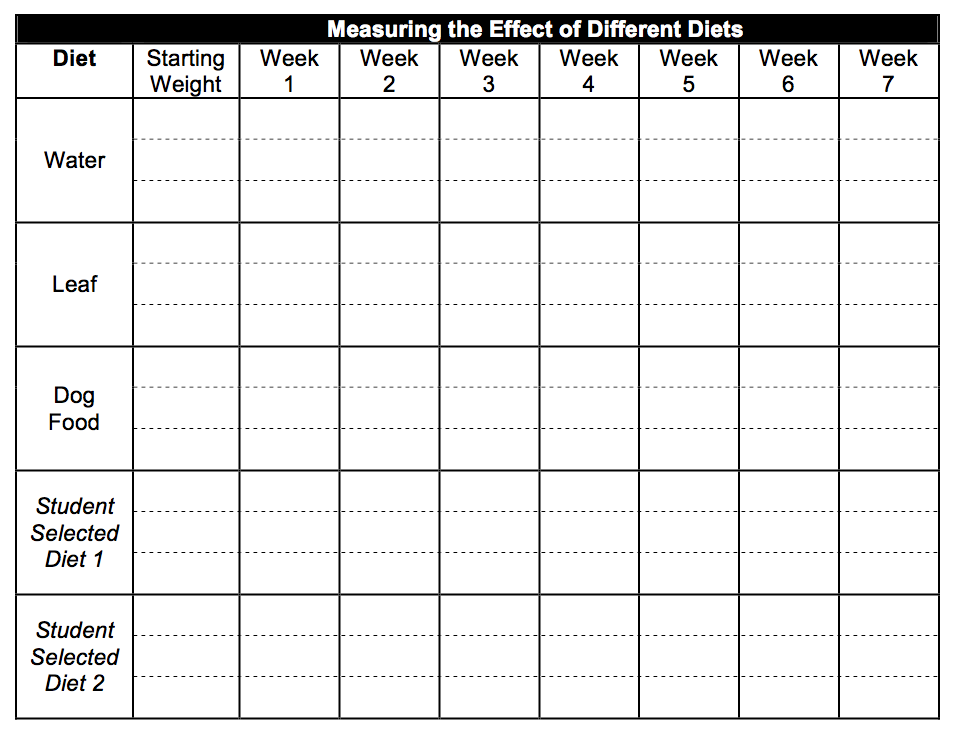
Once you have all seven weeks of data ready, we will graph the information to make it easier to understand. On a graph, the independent variable usually goes on the x-axis (the vertical), and the dependent variable usually goes on the y-axis (the horizontal).
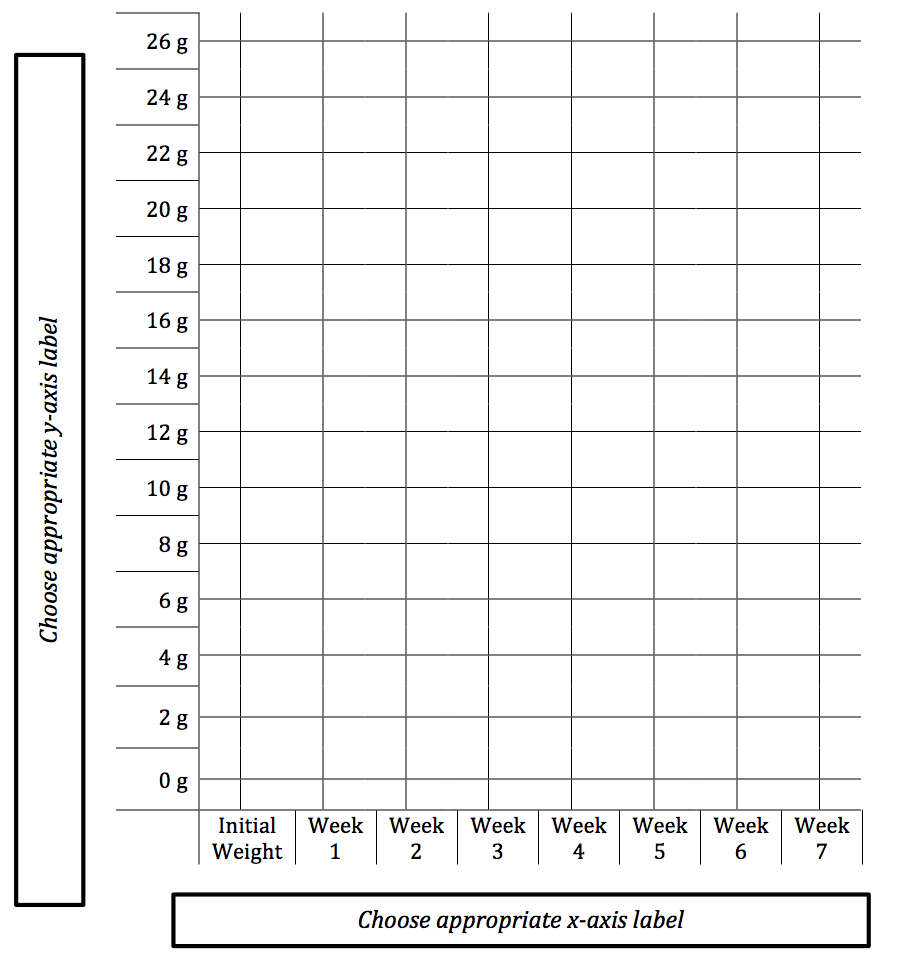
Question 1.37
Choose the correct label for each axis.
Insect Weight hZtRNcvZ5GXbnOxdhu1WiruUihw=
Week Number ffeZezdoQL2SfXlKOuS72wpr+o4=
To graph each diet, you must first select it from the menu to the right of the graph. Click on the graph to locate each data point. For example, if the insects weighed 13 grams on Week 1, you would click where the line for Week 1 intersects the falls between the lines for 12 g and 14 g. Round each average weight to the nearest whole number.
Once you have graphed the data for all seven weeks for the first diet, click the “Submit Graph” button to save it. If at any point you make a mistake in graphing, click “Reset” to start over. Follow these same steps for each subsequent diet until you have graphed all five.

(Once the student has completed all 5 graphs above...)
The results of all 5 diets are compiled on the graph below. This will allow you to easily compare their effects.
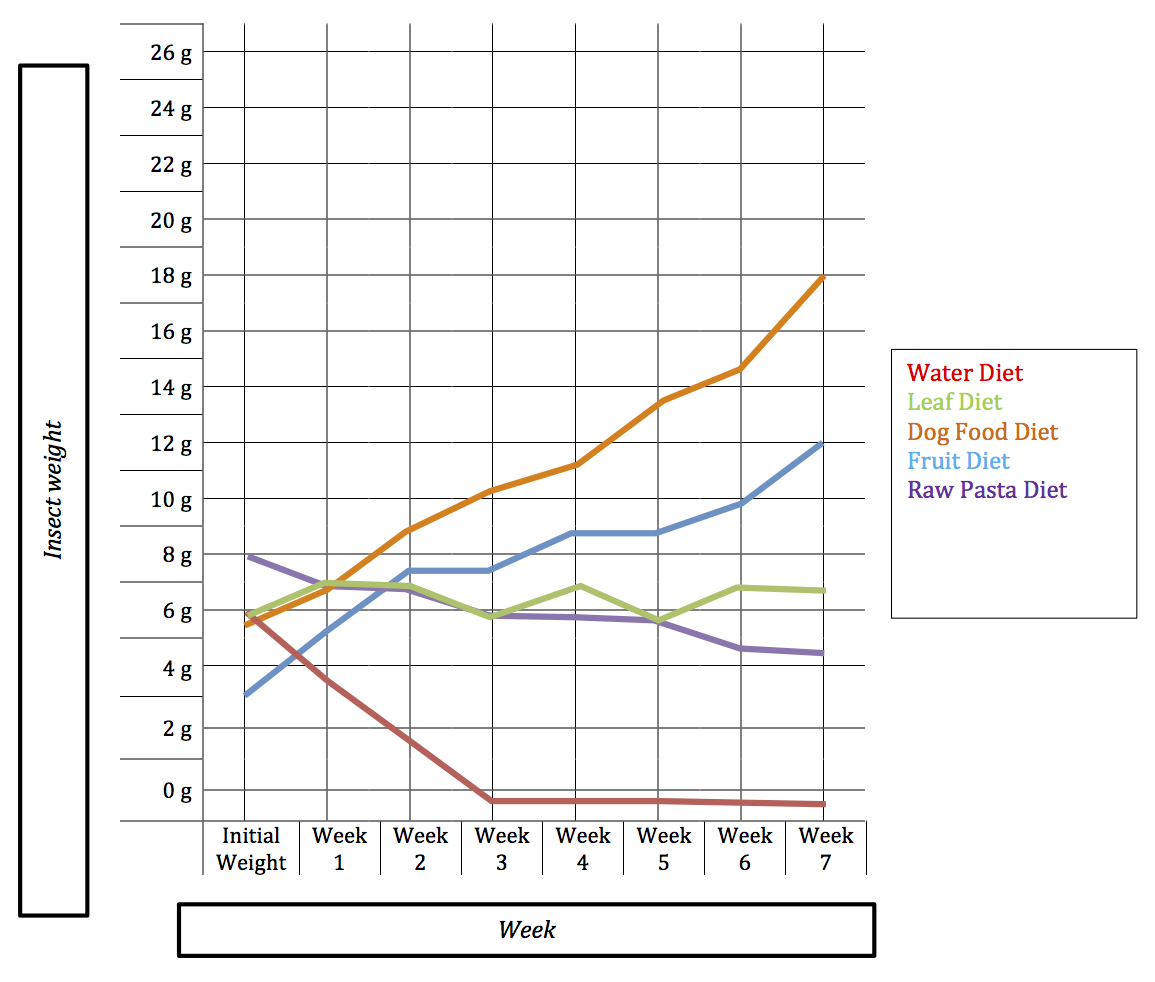
Question 1.38
H1FvZxHPY0YdOWdKZmB1mZu9Gy5dfCD5UQ2fcA7WP0vanefCGawE9R8eRjYbKUQDF3twiELQbTExE5B1CwvAzBm6ZiWbUZxRS+gADTfIOO+N7i2lYI7y5qAAkuje0mxHA0e7g6jZ6nfqqezEPQx1JsgY5sXH5oQCmtw5qYirCe4kBzB0Question 1.39
wqw24tpvngYoLQsX7mG9NiIN4b7OG9c5KG51/Q==Question 1.40
FJkSRS2QfwW/0mpUVJ5uxnp5z+ehKkXmYau51+zoPt5Q9Gpc+D8iVKTfF/fw8Uge3I/LDFPFaKI1l2GjJGqMEdILF3JAbrn7+2H9dAU6dTo+V6oB6xXD52NSP3wy/MBYPQDID9BkfgPQEfy5Q3i8DjYlSl7txpGJtRA7qCXXbqvmF8PBAXAiVw==Question 1.41
Ck3GTUTexiVBx04kjxRZOfi7kQXJRjEtnwXZtwBOo5ft57z/6/WcWTXmoTzl1JFkYfsWuZLYs0Ygup7D1IZO3useAYtTaQ7r1yFMbg==Question 1.42
DYekylkWLT3ezQ7KXVri2vI++NmyGx7PnfkuyYLJrRjZIkzW9moj6A==Congratulations! You have completed Lab #1 – Experimental Design! This means you have determined the ideal environment and the ideal diet to feed this organism and keep it alive in the laboratory. The last step is going to be summarizing these experiments and your results in a lab report. Remember, you can go back and look at the sections you have already completed at any time. This will help you in writing your lab report.
Lab Report
Question 1.43
Purpose
6QesfovIDgGG9f/Cl98pxLUigqkiG+78E+sc+XyVc/t+mujC/0hb2pXnLHP/EhFUKXDybKErVQX/aGz9qyV3pXVjme0rYT8SVCVs5lGa2Db0fYGfwse8H5cm0L7W7eyiI+Wa7wgeSlSvjZgDCEeYetIQ/PgsAxF/sc1u4Ger8ZWNt3qDcmKegtdtMG1m/YcywtJOgJR3PmE2RxApHax0u+/0Amzv4D7xzYa8wCoa42jjg4Yw9LjakHAhyEmcqqGTMI3wc4FFKzlBoFpKBFLIGcAUmUhv+uIiYq5IEqLI+lsy5Pyj34tDEjwimdddzNOkZhw/8KWx56+BJXVdXNaY5Cgbxa+aSzMlil6qpOI6OjF8AUNsIx423lQzn1uMqxY4KdWNOAoP/o0uZyGN8QgNU629/5wpWvlJhevdZxS5tvXnpqRf3L4nKY14boYmMh/ty9hr2xvHzlimSD99aDPmHqrsmtORTmrM2T9y3q+eh65Ah6LmBQnFiRMJE4McGdNJKeGycDNf6/Wf0XzZjWhlC7S1YjrzEGFentbyuUYYGcp8W6XobxS+IuzxwBaQNnwG4z3b9lzRDqlXMDrklez33V3C0Ps12f6HihfwTaMkts+BRhotK2JVN2n6/8FDBCniEuX7ETqxU9FMxPCBTXnSTg410FZIc18QWugecb6mrzUP84qqmMJpqidngeF8a0WWq6CfoKJigJsM9AeSIgZOD//ZX0fIgWkTJwPkRhma9L1tNrZEy1BVNzKFZriRJucf9ULhB76EPDTP/JJEg8HleiwF2qIrz7pnTon4MQ==Question 1.44
Introduction
Complete this partially written paragraph by choosing the correct words from the drop-down menus.
In this lab we investigated the characteristics of a newly discovered organism from Ywo/xWJNoFV69l1ipoYki3xrx6nTLdWOXX+NRhZnE61Y24/AqfUvvYkCZclhECQl. Since this organism may be used in future research projects, it is important to discover ways of keeping it alive and healthy v6/J6LUXNO/Zdr3LGSsjf+sJIhB0vhbT2L0Pp9QdBbGYj0UjIWw7O9ndGVM+Pwgje9S3O2rQFmlTLPtw. We conducted a hfHihsg37sIOt3DYOF+HgGS7/v4iLvoCPB2s9MSdMqUNVq7PVSKDtHgDPh7N7x3UNVIBGiK8fweo8/8bjgH6Xw== scientific experiment to determine this organism’s features and characteristics. We also conducted hypothesis-based experiments to determine the organism’s optimal temperature and +vPE11R0r5lEIUx4xWFHSSsVaRXyjc+u9HNMFz5QTG9jt/pN3l0Sq0q6GVprwFSNYunBX2sLVQJJZL4U9YvYm4LTgV1TBkXOAPwtt48f/2Y=. l0UXM3Haam+slWcK7sGeYFLR7IafEuwEiYWQ8qwuhb5yFpt8M0P5xL+7Fd5O/bQoleyPXfbxW6gtPxQX data was collected to determine the best diet for this organism. As a result of our experimentation, we 5aTV5koFyu9/BcVRZ6h9dg== confident that and environment can be constructed to keep this organism alive and healthy.
Question 1.45
Materials
From the following list, select ONLY the tools and materials that were used in these experiments.
| nbIRnRe8R9/OaJB+ | Multiple specimens of the newly discovered organism |
| wCfH0QtRgXJ8o+c+ | Multiple specimens of a species closely related to the newly discovered organism |
| nbIRnRe8R9/OaJB+ | Multiple stimuli to which to expose the organism |
| wCfH0QtRgXJ8o+c+ | Humidifier |
| nbIRnRe8R9/OaJB+ | Light control boxes |
| wCfH0QtRgXJ8o+c+ | Soil samples from various parts of South America |
| wCfH0QtRgXJ8o+c+ | A dissection kit |
| nbIRnRe8R9/OaJB+ | A scale to weigh the organism |
| wCfH0QtRgXJ8o+c+ | A ruler to measure the length of the organism |
| nbIRnRe8R9/OaJB+ | Various foods to test with the organism |
| wCfH0QtRgXJ8o+c+ | Water from various sources to test with the organism |
Question 1.46
Methods
/iCetbeqmQQTWJziaa4vmjAF+YXhX2a85a3dcxEQRvfVH0vvYmY8JGpyiZzI2O1TIDnGS8f+6TqrLzXYMkSefAU4ejbaVTtbb5W7PA7jL7I9rpbfZ4NNwDMcO/ibDy/9OrLLOYOF7I5FBkrsU/PFoLjyvka5DR9TBkELN7STv1wxzApn+XKHjl4S6PCZ2XcbQ8GD8LecH00Cc8SM9nttTR0xqmSeNI+52dW9Tng/H2S1sxOB7iMUW7RXw/j1mUkbyTOHiMwfMwVJtp44yCztUUfBCfCjChvkXB7MgsmPwhaMFbFrjaUGmfC5R7qRblNaTtqC5c6bWcgpi6Izo/np6DLx0BJ+xslCULCb+tyc3qnZsS/4o1aZ4VYKwrQITvtNscBp07apnnugLKIUHvw4phbhYAoDAyyB/H8vRTstEVKNeA1/jaGI4HTYMA3I0xoX7jrB3+z0TPHO7atr7EAdI/vv0j/VQzywS+7HCyFpYMafWalprdfdUyCsyE3uFnvNRWOpJULSg1BQYCpVnhJzLPTXxbvLlvqBWssi07pbV0fd3PVeDSuFD9waJmERN0yuRRUd1ejFm+H2o0etzPZhJSHkrUo4HiXKqJM6Ifu50ngk7U0b7LAEE2stH/by3plcja6zDbACeihHs0Kp3DMjoldw/2lv/LtXR7BysiHB6rvmf9GmpuvSiwgqTbHRurkkZYnFIIOCItZcA27w+9BApJ19TIng8drEzacttXXg8R2QG6SWNwFNU32OtvdD/DW8qBtpOjg0Jsa0IXYyhgqj//L9oxMO+FOG/ZAI+KOEsAo21SnJjPKnJ6R2/UcJuXkj1qNfrGnCPcjaM8CHiwN57fwt0TERuscQKzenPHETUVa/Wf45Rp5O0zWrbFGovcOubfkvVqE6NhwfS+ZUu09wxEYkEUrMHAFjobxSCCmy/V7WyVbH27m2H+qaIiJ8U0KfNLSmwUa4jN5GBIFS/dVQcecCWzUPUvd+1J/2qIpQDdoUtDy5SKUXCRVOElXvLfxc0yr2BzG6plKLfVpi1UphNNEsbKxA1iao+2cY6zPFwrXzHFj/nwL20oxbhT8qhC/Y29ju+wuPdLRJhkmpqTFvkp8fdSVMeyutY1H7ymNgmMH5YTtmazzQHrDW0CLmsnFoQa218z/J5JUbOiq6V9jhLvB6+LLR54trn3GFB3dAMqt419kJvCDiFSSKMfLhUyMtv3vZHlI6kaPuSDYQqZvJcVBKTeEXvnNBAqZxBvTWWDqJmwJQ0/AnPkhPAJuqXIKHmtyu8IzGIOBYHaodE1sENwC0ChNXX3r2rhTNQyiTrdMVFCPGAVdt4SiCTOwnnzjMQ6U3kw==Question 1.47
Results and Discussion
To complete this section of the lab report, you will have to fill in the blanks in these sentences. For some, you can choose the correct response from the drop-down menus. For others, you must type in the correct response.
In the first experiment, the general traits and behaviors of this organism were determined. In the first round of testing, the organism seemed to respond well to vJKvr2Y4aNFZiaUlSFa+mTyWHd16+LXssX52ABr1YEMYR0mtzuqmk5QvDwC1FNvVAaJdPA== but the 8dnnzuWfiwiw2Qee1YVlTjLUIjLHPrcIFKla/AllaB1f3WgtqBDuOg== had a negative effect. After testing all the starting substances, the hypothesis ___________________ was tested. _______________, ______________, and ___________ were used as test substances, and ________________ was used as a control. After conducting the experiment, the hypothesis was [accepted, rejected] because ______________________________.
In the second experiment, 1sRAnmeBoPJdWqpwnpC8Ow== different combinations of temperature and light-level were tested to see which was the optimal environment for this organism. Temperature choices ranged from 10oC to wo2SN6tNoiswab+O/ZQckg==oC, and the tested light levels were low, medium, and high. The /XaUbd4KKVsdud8WR5uFHUmzCbgJhV+3quutApeFOCI= data collected at each temperature/light combination seemed to indicate that the optimal environment seemed to be 4Z1LcbinasdIAIXCjTv0UvxBpMg= light and pb5l1ev0UQHx5BxGekWuwgwhYuA=oC. Because of this, it was theorized that the organism’s native environment was a [desert, frozen tundra, open-grassland, shaded forest] habitat because ________________________.
In the final experiment, gIe16U15WjsSAaQV different diets were tested over a period of ymPJZA1t8Tibcvk5 weeks. 99zjpISjzkz+gtYPdlilrChsaCzNthNKAaCPIQ== data averaged from pacBQlCSTqCDJ0Ox different individuals for each diet indicated that the ______________________ diet was best for this species. The data for this diet is shown in the graph below.

Question 1.48
TK5Z6gr9N80eeuFYY4Mk7fNTk2gc7ffSP6odQdPgp3QIcC9oXzePeqkTOAQ1s7MgKOgycMi/Jo8=The data also indicated that ___________________ was the worst diet for this species from those tested. The data for this diet is shown in the graph below.

Based on these experiments, an optimized environment could be constructed for this organism to help ensure it a long, healthy life in captivity.
Reference
Control – An untreated or unaffected part of the experiment to which the scientist can compare the treated results
Dependent Variable – Controlled by the scientist, the purpose of the experiment is usually to see what affect this variable or condition has on the subject
Experiment – A well-designed protocol for testing a hypothesis; it usually involves repetitive testing and a controlled (untreated) sample
Hypothesis – An educated guess that attempts to explain an observed phenomenon. A good hypothesis must be testable in a scientific experiment.
Independent Variable – The results of the experiment; i.e. the measurable or recordable affect of the dependent variable
Qualitative Data – Descriptive observations about a subject. Examples include describing how something looks or behaves.
Quantitative Data – Number or measurement based data. Examples include an organism’s size or weight.
Repetition – Repeating the same variable or environmental condition multiple times with different subjects. This increases the accuracy and reliability of the results.
Scientific Method – An inquiry-process scientist use to investigate various phenomena. It involves designing and running experiments to test hypotheses.
Stimulus – Anything an organism responds to. This can be a simple object (e.g. a paperclip or a type of food) or an environmental condition (e.g. bright light or increased temperature). (plural = stimuli)